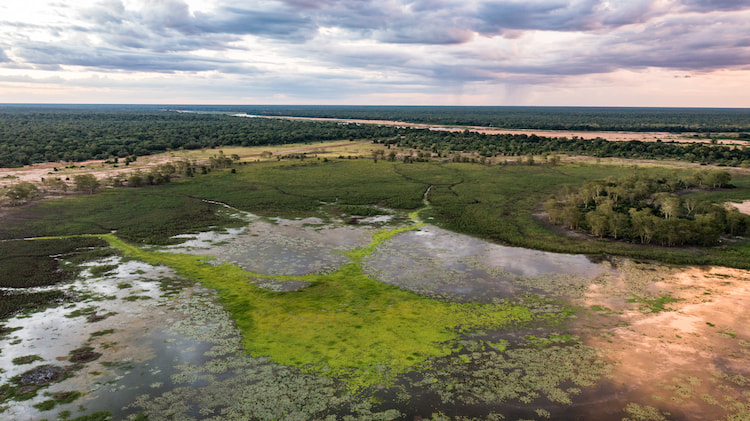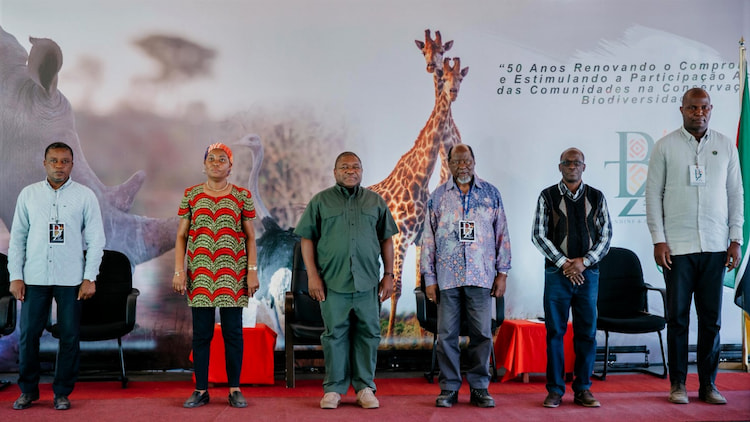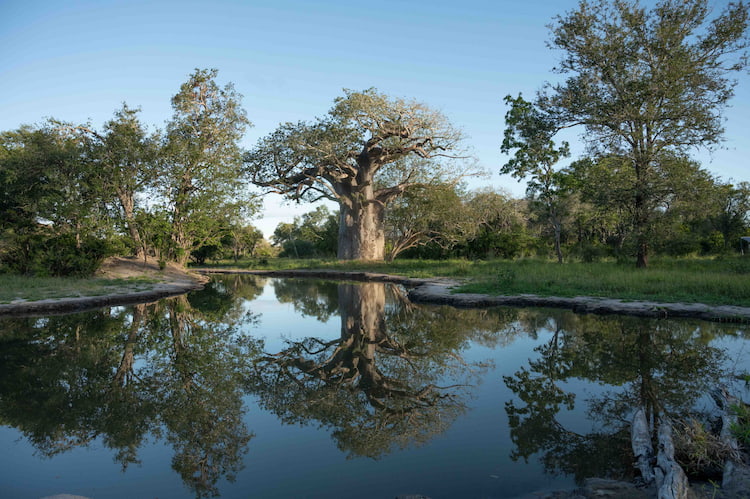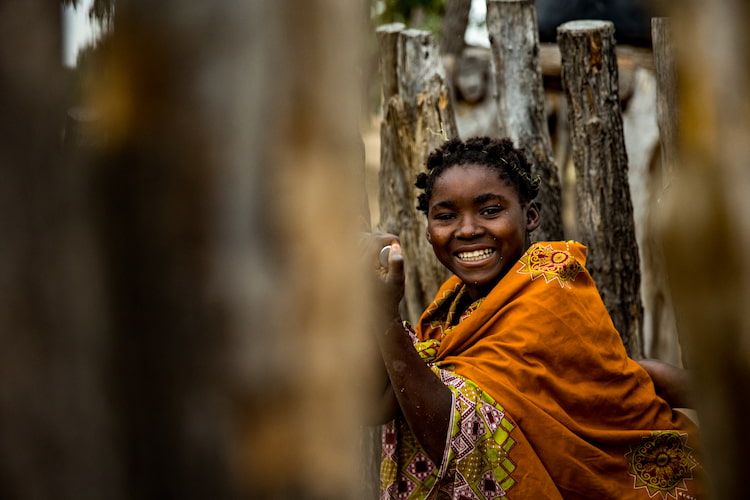Along the Savé River, in the North-West of the Province of Inhambane, Zinave National Park transitions between the wet tropical lands and the dry lands of Mozambique; it represents an important crossing point for the nomadic animals migrating through the region. Giraffes, an icon of this park, lope through vegetation rich in acacias and mopane forests. Ancestral baobab trees hint at the age of the landscape, where traditional fishing and rain ceremonies, ancient tales and sacred locations are interwoven with the region’s wildlife.
On Monday, 26 June, in the wake of Mozambique’s Day of Independence, the country’s President, Filipe Nyusi, celebrated half a century of conservation in two of his country’s most treasured national parks, Zinave and Banhine. Joining the commemorative event were communities local to the parks and representatives of Mozambique’s National Administration for Conservation Areas (ANAC) and Peace Parks Foundation.

In active acknowledgement of great efforts here to restore, rewild and revive the relationship between conservation and communities, the President assisted in the tagging of a buffalo bull – one of the key Big Five species – naming it ‘Reconciliation’ to represent the establishment of peaceful coexistence between people and wildlife, and the value of a holistic, harmonising conservation approach.

Africa: Conservation on a Continent of Change
Africa has a hallmark richness to its existence, portrayed in Zinave’s present-day picture of Savé paradise; a sense of plenty shines through forests and along river banks. Yet, in its 50th year of being, this is a recent state of nature compared to the park’s past. To the south, Banhine National Park, celebrating its half-century alongside Zinave, is also a newcomer to good health and great hope.
Traditionally, and like much of Africa, the people in these areas lived in harmony with their land, and the philosophies of sustainability and conservation were inherent in society. Chiefs and tribal councils had absolute authority and kept the rules of resource control and so protection of the landscape. June 1973 marked the declaration of the two national parks – assumed to be the beginning of long-term prosperity there. But the conflict was quick to rewrite 16 years of cultural and environmental history, littering both protected areas with the chaos of the civil war – which upset delicate ecosystems and decimated wildlife.
Globally, we are in an era of unprecedented change and are pressed for time. Environmental, social and financial shifts are being felt starkly in the southern African region; the challenges of Mozambique’s chequered past now give way, in the present, to a new and unique suite of threats. Like its neighbours, the country faces a changing climate, diminishing biodiversity, competition for natural resources, and communities feeling this heavy load. Yet this insightful nation rich in nature and heritage holds promise: seeing the value and potential of what it has and the challenges raised, it is leading by example.

"I salute and thank Peace Parks Foundation, our partner in the organisation and management of Banhine and Zinave, for its unequivocal commitment to developing conservation solutions which generate benefits for the local community,” said His Excellency President Nyusi. “More than 40,000 people earn income for their livelihood thanks to this conservation activity. Our partnership with Peace Parks Foundation and the regional collaboration in the area of conservation between our country, Zimbabwe and South Africa is an example to the world of shared commitment between different governments and non-governmental actors. This partnership implements the vision of living in harmony with nature, specifically in the implementation of the new Kunming-Montreal global framework on biodiversity, adopted in December 2022."
In this anniversary year, as Banhine and Zinave turn 50, Peace Parks celebrates its 25 years of existence. The three sizable milestones represent a wealth of combined, accumulated knowledge from a visionary government and a unique third-sector organisation journeying together.
To date, and with the invaluable input of partners, Peace Parks has borne three generations of progress across transboundary landscapes. From rousing the political will to conserve at scale across borders to implementing, connecting and restoring on the ground – now to pioneering, in this new innovative era of strategy, true partnerships in co-management, which seek transformative change at a level that matches the magnitude of the challenge. Work has been focused on the vision of restoring iconic African landscapes in this vast area by bringing countries together and partners within countries to reinstate wildlife populations and strategically develop protected areas where wildlife and people can co-exist in harmony. The organisation’s impact-driven Strategy 2030 both reflects how far we’ve come in successes and lessons learned and acts as a roadmap setting our pace and direction of travel forwards. Vision 2050 proposes bold action at a vast scale – critical if we are to absorb the climate and social shocks anticipated across southern Africa.

Strategy 2030, in step with the 30x30 global goals, is driving the critical impacts made possible by conservation at scale: reconnecting Africa’s wild spaces through transboundary ecosystems and corridors. Vitally, at the core lie communities able to share knowledge, decision-making, resources and revenue in a commercially viable way. It is an approach that enhances resilience and empowers local people to guide the development of their own landscapes, focusing on thriving wildlife, secure livelihoods and connected protected areas where benefits overflow to their surroundings.
Vision 2050 takes this strategy across Africa, with the intention of building an interconnected, continent-wide ecological infrastructure on secure and peaceful foundations and through local partnerships and international cooperation.

Mozambique’s Journey: Challenging Past, Flourishing Present, Nature-Positive Future
With a quarter of Mozambique declared as conservation space, ANAC – a state institution responsible for conserving biodiversity and the sustainable development of the country’s ecotourism – has its work cut out. But dazzling progress proves that it is grasping confidently what it takes to ensure oversight and connectivity across its protected areas and the transfrontier conservation areas to which they make a game-changing contribution. ANAC dedicates itself mainly to the planning, coordination and execution of activities in the conservation areas in partnership with local organisations and communities, raising both awareness and high standards as it does so throughout the country.
In 2002, the Governments of Mozambique, South Africa and Zimbabwe entered into a Treaty to establish the Great Limpopo Transfrontier Conservation Area (GLTFCA), spanning over 100 000 km2 and incorporating five national parks, including Zinave, Banhine and the iconic Kruger National Park in South Africa. Peace Parks played a significant role in facilitating this process and has supported the development of the TFCA since 1998.
As part of this agreement, the governments of Mozambique and South Africa are working together to rewild Mozambique’s national parks. Zinave and Banhine hold shared interests for both countries, being crucial anchor parks for ecological linkages – natural migratory ‘walkways’ – connecting the two.
In 2015, Peace Parks Foundation signed a 20-year agreement with ANAC to restore, develop and co-manage Zinave National Park, marking the beginning of its rebirth. Three years into its remarkable transition from a silent to a vibrant protected area came the signing of a second pact, initially for three years, between ANAC and Peace Parks to collaborate on the joint management and development of Banhine, with discussions to extend the agreement. This signified a strengthening of the partnership and its capacity, boosting the rewilding and restoration of this globally crucial cross-border conservation landscape and highlighting ANAC’s significant contribution and the outstanding extent of political support available for these transformative changes to take effect.
“The integrated management of landscapes such as those of the Banhine and Zinave National Parks is complex. It requires specialised knowledge and synchronisation of actions between the various social actors, to implement the policies conceived by the Government. These conservation areas constitute a single ecosystem that is interesting to manage in a unified manner,” said His Excellency former President Chissano. “Our commitment to working with the government remains in the shape of whatever contribution is needed in order to restore and promote the ecological balance, so that each year we can celebrate successes and socio-economic growth in the region.”

Zinave National Park – Beacon of Biodiversity, Rewilding Wonder
Under the co-management agreement, Zinave’s activities over the past five years have included establishing a joint park management team, upgrading the park management infrastructure, training and appointment of additional rangers, wildlife reintroductions and various community development programmes. None of which would be possible without the generous support of our donors: conservation without funding is nothing more than a conversation.
Since 2016, an intensive rewilding programme has reintroduced more than 2 300 game animals representing 14 different species into Zinave National Park, including buffalo, elephant and leopard. Last year brought Zinave’s greatest rewilding triumph yet with the arrival of both black and white rhino, accompanied by advanced ranger training and conservation technology to ensure their future safety. The pioneer herds, to be joined by new blood in a third operation this year, were translocated to the park from South Africa in a bid to reinstate two keystone species and the vital stabilising, harmonising roles they play in the greater ecosystem. Within two weeks, a perfect little calf was born, blessed ‘Princesa’ by President Nyusi and declared both a national treasure and a beacon of hope for what lies ahead.
With the immense support of ANAC in contributing to the majority of wildlife moved within Mozambique, native species reintroduced has meant health and balance restored, and a return for Zinave to the conditions animals intuitively need to resettle and thrive. With no intervention needed, the first lions were recorded in the park after a 40-year absence, assumed to be migrating from one of the other parks within the GLTFCA. Increasing numbers of species can now cross the Savé River freely and travel vast distances from as far as Kruger National Park. This is a restorative sign and again affirms the vital role of connectivity between safe havens across transboundary expanses.
With these rewilding developments, Zinave can increasingly put a price on nature sustainably and benefit communities. A Big Five wildlife economy here is Mozambique’s first and an international win, but most importantly, it can deliver a vital revenue share to communities – then invested in schools, clinics and basic but essential services.
“The return of the rhino allows for Zinave to be introduced as a new and exciting tourism destination in Mozambique with the sought-after “big-five” species – the only national park in Mozambique that has elephant, rhino, lion, leopard and buffalo,” Werner Myburgh, CEO of Peace Parks Foundation, shared. "This will open doors for international investment and tourism development, which in turn will generate income to sustain park operations, whilst also giving back to the local communities who will receive 20% of park revenues and directly benefit from additional job creation and a whole range of livelihoods opportunities now being realised. This speaks directly to core mission of Peace Parks to create a future for people and nature to co-exist.”
The community component of conservation is what enables success, so for local people to be involved in sustainable development programmes is critical. Since 2022, the Hunger Project has targeted hunger and poverty challenges facing Zinave’s surrounding rural communities. The initiative builds self-reliance at the grassroots level, empowers women as key change agents, and forges effective partnerships with local government. People are being empowered to take the reins of their own development and unlock local capacity for change, structured around integrated programmes in health, education, adult literacy, nutrition, improved farming and food security, microfinance, water and sanitation, and building community spirit – with lasting and self-sustaining benefits over time.
The foundations established will ultimately create a ripple effect from village to village to create a better-serviced landscape which supports greater community well-being. Banhine National Park, still in the early stages of rebirth, is an imminent implementation site – one of a number of ways in which it is promised to grow in Zinave’s slipstream of successes and lessons learned.

Banhine National Park: Conservation without Funding is Just a Conversation
For Banhine to be able not only to mirror Zinave’s development but also to cut its own path, there’s a compelling need inside and outside the park for projects supporting communities. It is a true African wilderness, challenged by a harsh landscape and the conflicted coexistence of people and wildlife. Poverty, remoteness and a scarcity of resources have been compounded in the past by the devastating effects of large wildlife on livelihoods.
The park has taken significant steps to invest in its ranger force, often called upon by park management or community members to assist with human-wildlife conflict mitigation, and teams also educate those from the local villages on safe ways to deter wildlife. The park’s anti-poaching team consists of over thirty well-trained men and women amassing thousands of hours on patrol per year, successfully sweeping snares and securing arrests.
For much of Banhine’s existence, the park has struggled to survive but has seen out the tough times. With a fresh management plan and a clear vision come crucial new foundations and community initiatives. By securing additional funding, Peace Parks will be able to provide water resources to the surrounding communities as well as animals living in the park; alongside comes the rewilding of Banhine in Zinave’s footsteps by bringing back historic species and ensuring their safety with effective anti-poaching measures.
Infrastructure has been a core focus in Banhine, from a vital water system and housing to its airstrip and a radio network – all of which facilitate the present and future management of the park.
The Swedish Postcode Lottery is providing core support to the roll-out of the brilliantly successful Herding 4 Health across the region – a programme that is making remarkable strides in allowing communities to continue to live in a way that complements and enhances their traditional rangeland and livestock management techniques, and principles of co-existence, thereby assisting in the restoration of entire landscapes. The initiative was rolled out in Banhine last year and is already making great strides for livestock, livelihoods and revitalised landscapes.
It is incredibly rewarding on the ground to witness daily changes that translate, on a growing scale, into climate wins as more and more carbon is being returned to these ecosystems – thanks to wildlife and harmonious management. All of this and the positive co-benefits for agriculture and biodiversity are creating more adaptable and resilient ecosystems, resting in the care of knowledgeable farmers and eco-rangers, and contributing to a more stable climate.
Raising Africa’s Gold Standard: A New Era for Conservation and Communities across the Continent
The best practice examples being set for the rest of Africa by these national parks are powerful and immensely hopeful and speak to the value of bringing leaders, institutions, strategies and visions together.
“Securing space for restoring and rewilding has been a monumental conservation challenge in today’s changing world—yet there is plenty of reason to be hopeful, and Mozambique brings immense conservation opportunity and motivation. Success in building back biodiversity in Zinave and Banhine rests on our collective ability to make conservation a valuable industry for the communities surrounding the areas which, with support, we protect, by improving livelihoods, reinvigorating landscapes, and promoting human-wildlife coexistence. Working with ANAC, we are creating these vital benefits, and they extend to local people and wildlife; to biodiversity and to the climate; they are all deeply interlinked. At scale, Africa can experience these same benefits thanks to inspiration from countries such as Mozambique,” assured Werner Myburgh.
Zinave and Banhine are extraordinary and ongoing success stories which point to a gold standard being raised by these uniquely special protected areas. Stepping into these parks less than a decade ago, few would have imagined that decimated wilderness of this kind could begin to thrive again so soon, but it is coming about as the result of Mozambique’s sharp and long-range vision to restore natural resources in a way which will allow its people to thrive. It shows that reintroducing historic species and reviving habitats on this scale is possible with enormous dedication to building relationships with communities, governments, donors and private sector organisations.


